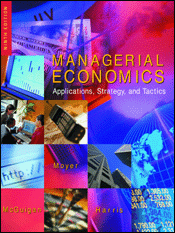James R. McGuigan
James R. McGuigan owns and operates his own numismatic
investment firm.Prior to this activity, he was Associate Professor of Finance
and Business Economics in the School of Business Administration atWayne
State University. He also taught at the University of Pittsburgh and Point
ParkCollege.
McGuigan received his undergraduate degree from
Carnegie-Mellon University. He earned an MBA at the Graduate School of
Business at theUniversity of Chicago, and his Ph.D from the University
of Pittsburgh. In addition to his interests in financial management, he
has co-authored books in managerial economics, including Managerial Economics
with R. Charles Moyer. His research articles on options have been published
in the Journal ofFinancial and Quantitative Analysis.
R. Charles Moyer R. Charles Moyer holds the Integon
Chair in Finance in the Babcock Graduate School of Management at Wake Forest
University. Previously, he was Professor of Finance and Chairman of the
Department of Finance at Texas
Tech University. Professor Moyer has also taught
at the University of Houston, Lehigh University, and the University of
New Mexico. He has also spent a year at the Federal Reserve Bank of Cleveland.
Moyer earned his BA in Economics from Howard University,
and his MBA and Ph.D in Business from the University of Pittsburgh. In
addition to this text, Moyer has also co-authored Managerial Economics,
and Financial Management with Lotus 1-2-3. He has been published in many
leading journals, including Financial Management, Journal of Financial
and Quantitative Analysis, Journal of Finance, Financial Review, Journal
of Financial Research, International Journal of Forecasting, Journal of
Economics and Business, Journal of Industrial Organizations, and many others.
Frederick H. deB. Harris Frederick H. deB.
Harris is the McKinnon Professor of Managerial Economics and Finance at
the Babcock Graduate School of Management, Wake Forest University. His
specialties are pricing tactics and capacity planning, two topics that
ideally integrate functions traditionally ascribed to marketing, operations,
and finance. Professor Harris has taught integrative managerial economics,
marketing, and finance courses in three business schools in the U.S. and
Europe.
Professor Harris has published widely in financial
and economics journals including the Review of Economics and Statistics,
Journal of Financial and Quantitative Analysis, Journal of Banking and
Finance, Southern Economics Journal, Journal of Industrial Economics, and
Managerial and Decision Economics. From 1988-93, Professor Harris served
on the Board of Associate Editors of the Journal of Industrial Economics.
His current research focuses on the application of capacity-constrained
pricing models to specialist and electronic trading systems for stocks.
In addition, he often benchmarks the pricing, order processing, and capacity
planning functions of large companies against state-of-the-art techniques
in yield management and writes about his findings in journals like Marketing
Management and the Journal of Operations Management.
